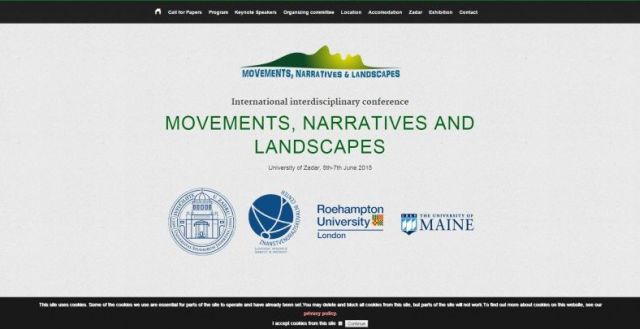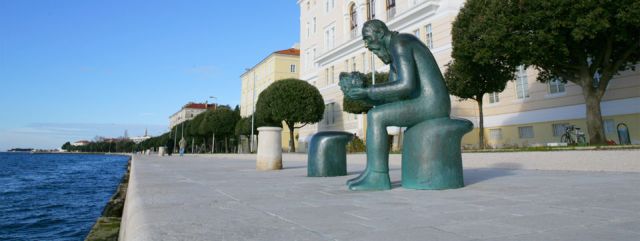Na konferenciji MOVEMENTS, NARRATIVES AND LANDSCAPES održanoj u Zadru od 5. do 7. lipnja 2015. sudjelovali su članovi istraživačkog tima projekta Second Homes and Social Sustainability of Local Communities in Croatia s dva izlaganja u kojima su prezentirani rezultati do sada obavljenih analiza na projektu Instituta Ivo Pilar – O projektu

– Web stranica konferencije MOVEMENTS, NARRATIVES AND LANDSCAPES; Zadar, 5.-7. lipnja 2015.
U Zadru je od 5. do 7. lipnja je održana konferencija MOVEMENTS, NARRATIVES AND LANDSCAPES u organizaciji Sveučilišta u Zadru, Scientific Research Centre of the Slovenian Academy of Sciences and Arts (Slovenija), University of Roehampton (UK), University of Maine (USA). Na konferenciji su sudjelovali članovi istraživačkog tima projekta Second Homes and Social Sustainability of Local Communities in Croatia s dva izlaganja u kojima su prezentirani rezultati do sada obavljenih analiza na projektu. Roko Mišetić, Nenad Pokos i Mario Bara sudjelovali su s izlaganjem “Changes in Features of Housing Units: Croatia 2001 – 2011” dok su Geran-Marko Miletić, Krešimir Peračković i Marica Marinović Golubić imali izlaganje pod naslovom “Dwelling in Multiple Landscapes: A Sociospatial Analysis of Second Home Phenomenon”.
– Program | Keynote Speakers

Sažetci izlaganja
1. Changes in features of housing units: Croatia 2001 – 2011
Roko Mišetić, Catholic University of Croatia (roko.misetic@unicath.hr)
Nenad Pokos, Institute of Social Sciences Ivo Pilar (nenad.pokos@pilar.hr)
Mario Bara, Catholic University of Croatia (mario.bara@unicath.hr)
The paper analyses functional and physiognomic changes of housing units on city and municipality level in the Republic of Croatia from 2001 up to 2011. Functional changes are analysed according to statistical categories of housing units, while for analysis of physiognomic changes the authors used data on number and sizes of the units. During the past few decades the total number of housing units in Croatia is continuously growing as well as the number of units within specific statistical categories. The same trend exists when analysing the size of the units – in addition to absolute growth, records show increase in average size of housing units as well. The analysis of last inter-census period, when the total number of housing units increased by 19.7%, shows that the change in total number of housing units, as well as change in the number of lower level statistical categories is spatially differentiated. While coastal region and the capital city register a relatively strong increase in the number of housing units, central Croatia stands out at the other end with the lowest increase rate. Among changes that affected lower category housing units, increase in apartments for secondary housing stands out. Between 2001 and 2011 their number increased by 36.6%, with highest rate recorded in coastal cities and municipalities. Census data also indicate the expansion of number of temporarily vacant housing units during the analysed period, which is also a continued trend from earlier periods. The significant increase in temporarily vacant housing units during previous decade can be in one part associated with the economical crisis and recession that created an excess of units on the market. On the other hand, the reasons can also be found in the fact that registered changes are not following the rate of demographic development of Croatia. Increase in the number of developed units does not reflect real needs for housing, but can instead be interpreted as a sort of preservation of value when considering citizen’s savings. This, however, represents the “occupation” of space and its permanent dilapidation.
– Prezentacija: Changes in features of housing units: Croatia 2001 – 2011
2. Dwelling in multiple landscapes: a socio-spatial analysis of second home phenomenon in Croatia
Geran-Marko Miletić, Institute of Social Sciences Ivo Pilar (geran@pilar.hr)
Krešimir Peračković, Institute of Social Sciences Ivo Pilar (kreso@pilar.hr)
Marica Marinović Golubić, Institute of Social Sciences Ivo Pilar (Marica.MarinovicGolubic@pilar.hr)
The number of second homes in Croatia grew rapidly in the last intercensal period (from approx. 182.000 in 2001 to 250.000 in 2011) and as a result, second home expansion continues to be one of the strongest factors of spatial transformation in Croatia with coastal regions being most affected. Having that in mind, focus of this analysis will be on social and spatial patterns of second home expansion in Croatia. Starting from the fact that second home use implies not only (temporary) change in place of residence, but also, very often, movement to different landscape, the main aim of the analysis is to find out what kind of landscape do owners of second homes in Croatia prefer and what are basic characteristics of Croatian households that have a second home.
Specific objectives of the analysis are as follows: first, to describe spatial distribution of second homes (settlement size; type of settlement: rural/urban, core/peripheral, developed/developing; location: Continental/Adriatic region); second, to get insight into main features of places of primary residence (places where families with second homes permanently live); and third objective is to compare households with and without second home based on their family, economic and housing status. Part of data for the analysis will be taken from the 2011 Census. However, as the data about second home owners in Croatia aren’t collected with the Census, data from an empirical research on the national representative sample conducted in the autumn of 2014 (N=3000) will be used for getting insight into socio-spatial background of Croatian households with a second home.
– Prezentacija: Dwelling in multiple landscapes: a socio-spatial analysis of second home phenomenon in Croatia
>>> PROJEKT: Second Homes and Social Sustainability of Local Communities in Croatia

 Institut društvenih znanosti Ivo Pilar Pilar
Institut društvenih znanosti Ivo Pilar Pilar



